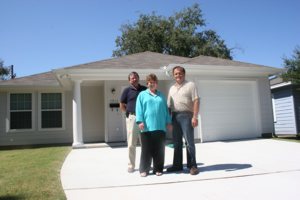For years, Pamela Monday had been living in the 661-square-feet home she inherited from her beloved mother. It was built in 1953 and lacked many of the modern amenities and conveniences. Pamela’s disability and lack of resources prevented her from being able to repair and modernize her home.
In talking to a family friend, she learned of the City of Plano’s Housing Rehabilitation Program. Pamela said “Being disabled and on a fixed income there was no way I could afford to have any improvements done to the house. I was hoping to get repairs as the house was pretty old and pretty dilapidated.” After meeting the program qualifications, the City inspected her home.

Unfortunately the inspection indicated her beloved home did not meet minimum property standards for rehabilitation. Instead it was eligible for the tear-down and rebuild of the residence (i.e., reconstruction).
In February 2009, construction began on a new 1,000-square-feet residence for Pamela. She moved into her dream home in early July 2009. “They went beyond my expectations by demolishing the house and building a new very energy efficient house that would also accommodate my health concerns as I got older,” commented Pamela. She noted that the energy savings have been averaging $200 per month.
Plano’s Housing Rehabilitation Program has been helping Plano residents for more than 30 years through funding by the U. S. Department of Housing and Urban Development (HUD). The HUD funds are primarily used to complete housing repairs considered essential to the health, safety and welfare of income qualified families.
Not all homes are completely reconstructed like Pamela’s home; some households and property may qualify less drastic housing repairs. Those repairs may include a new heating and cooling systems; roof repairs or replacements; energy efficiency improvements; siding replacements; accessibility improvements; foundation repairs; or plumbing and electrical repairs. As with reconstruction, both the household and the property must meet the City and HUD’s program requirements prior to commencement and completion of the repairs.

Another aspect of the housing repair program includes emergency repairs. An emergency is one that is recent in nature or would otherwise cause harm or injury to the household. Emergency repairs are at no cost to the household. The household qualification process is shortened in order to address the emergency. Typical emergencies include new heating and cooling systems, and electrical and plumbing repairs.
Interested Plano residents may obtain information about the program, the qualifications and an application by calling the City of Plano’s Community Services Division at (972) 941-7151 or visiting the City of Plano Planning Department Web site at www.planoplanning.org.
Pamela’s advice to other Plano residents is “If you have a home that is run down or in need of repairs apply for this program as soon as possible. I can’t say enough good things about this program and the people who work with you.”









I am a friends of Pam’s and cannot tell you how excited she was when she qualified for this program. She now has a beautiful home with everything in it she will need as she gets older. She cannot say enough good things about all the people who did this for her.